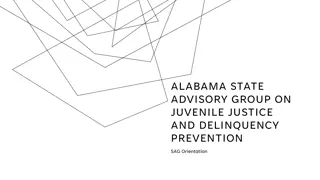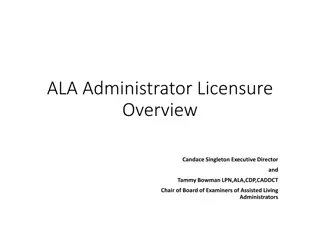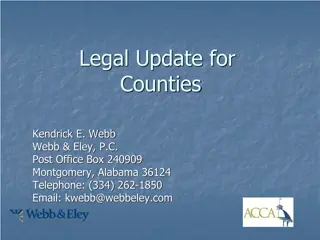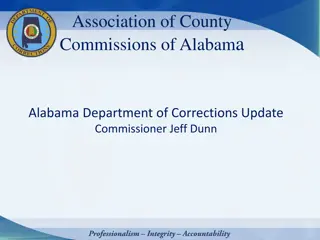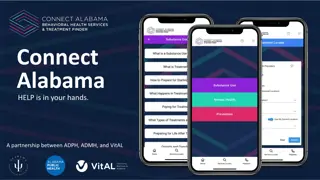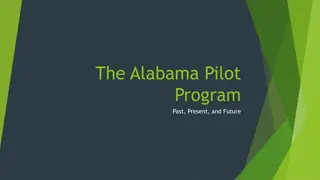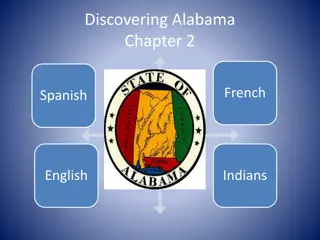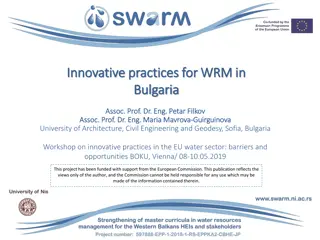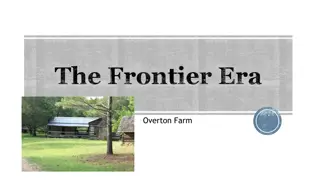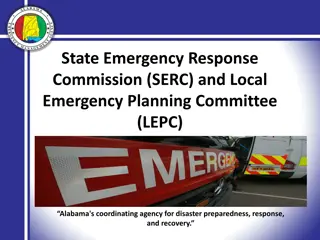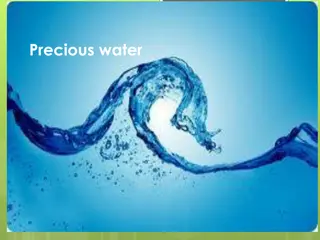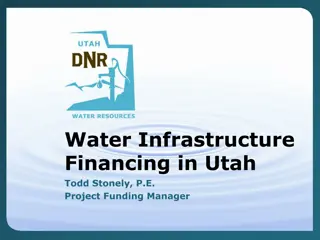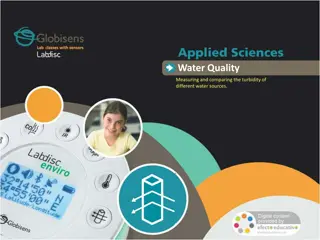Exploring Water Education in Alabama: Activities and Resources
Dive into a comprehensive water education program in Alabama focusing on the importance of water for life, unique characteristics of water, and the preservation of water resources. The program covers essential questions, activities, and resources for understanding watersheds, water sources, the water cycle, and more. Engage in hands-on activities, explore interactive maps, and enhance your knowledge about water conservation through engaging lessons and homework assignments.
Download Presentation

Please find below an Image/Link to download the presentation.
The content on the website is provided AS IS for your information and personal use only. It may not be sold, licensed, or shared on other websites without obtaining consent from the author. Download presentation by click this link. If you encounter any issues during the download, it is possible that the publisher has removed the file from their server.
E N D
Presentation Transcript
WATER IS ESSENTIAL FOR LIFE ALABAMA AG IN THE CLASSROOM NATIONAL AG IN THE CLASSROOM MOBILE, ALABAMA PORTLAND, MAINE MAY 30-JUNE 1, 2018 JUNE 27-29, 2018 Linda Hardee Presenter
Alabama: the River State Concepts : Water and the Environment ENDURING UNDERSTANDINGS * WATER IS ESSENTIAL FOR LIFE * WATER HAS UNIQUE PHYSICAL AND CHEMICAL CHARACTERISTICS * WATER IS A NATURAL RESOURCE WE MUST PRESERVE AND PROTECT ESSENTIAL QUESTIONS * WHY IS WATER IS ESSENTIAL FOR LIFE? * WHAT ARE SOME UNIQUE PHYSICAL AND CHEMICAL CHARACTERISTICS OF WATER? * HOW CAN WE PRESERVE AND PROTECT OUR WATER RESOURCES?
WEEK ONE THE WATER ENVIRONMENT Week One The Water Environment Orient to the activity - Look at a map of Alabama on-line http://www.outdooralabama.com/fishing/freshwater/where/rivers/rivers. pdf What do you notice . Look at all the blue Explain a watershed K-W-L on Alabama s water Look at another interactive map http://www.riversofalabama.org/index.htm Homework with your family (school to home connections) http://ga.water.usgs.gov/edu/sq3.html http://www.epa.gov/region1/students/pdfs/gwa21.pdf Prepare a chart or graph with your results 1. Do you use a lot of water? 2. Waste a lot? 3. Use resources wisely?
WEEK TWO WHERE CAN WE FIND WATER Week Two Where Can We Find Water Share results of homework, post graphs on the wall as an interactive analysis Orient to the activity Brainstorm a list of places we might find water (glaciers, groundwater, clouds, etc). Do this with your table group. Post this list Toss a globe and have the students catch it with their arms outstretched and fingers apart. Record the fingers on blue. After 10 catches, you should have between 65 and 90 fingers on blue. The earth is 70-75 percent water. Make a chart or graph.
WEEK THREE A WATER CYCLE IS NOT A CIRCLE Orient to the activity Brainstorm a list of places we might find water from group work Discuss the differences between a water cycle and a circle Activity Stations of the water cycle http://www.in.gov/dnr/nrec/files/pwdice.pdf - were the students surprised about water in animals (us) and plants? Explain how they will travel through some of the stations as a water molecule, collecting beads for their bracelet (I use chenille sticks, the beads generally stay put and it s easy to make a bracelet). Remind them to keep great notes of what caused the movement from one place to another (can review Talents Unlimited here Forecasting) Allow ten stops for this activity then name a station and see how many people visited. Did anyone make it to all stations? 10 beads-do easy percentages Write a creative story about your journey. Use the places you visited (in order) and tell about your adventures. Draw a picture http://www.riversofalabama.org/index.htm http://www.peelregion.ca/pw/waterstory/pdf/activities/bucket.pdf Homework with your family (school to home connections) o Share your bracelet and the story you wrote with your family. Have an adult sign your record sheet to indicate that you have explained the activity to them.
WEEK FOUR POLLUTION AND WATER QUALITY Share results of homework bracelet activity, ask about what their families thought. Orient to the activity KWL on pollution Freddy the Fish http://wupcenter.mtu.edu/sustainability/lessons/Freddie_the_Fish_Lesson_Gr2-3.pdf Nine sources of pollution: Sedimentation, Cow manure, Fertilizer, Weed killer, Road salt, Litter, Acid Rain, Industry, used motor oil Activity Using the Decision Making Talent, formulate a plan to reduce pollution in Alabama Rivers. o Think of many, varied things you could do ALTERNATIVES o Think of the varied questions you need to ask about the things you could do CRITERIA o Use your answers to help you make a decision WEIGHING o State your final decision DECISION o Give many varied reasons for your decision REASONS Homework with your family (school to home connections) o Talk to your family and friends, what do others think are the biggest pollutants. Talk about ways your family can make a difference.
WEEK FIVE WE ARE ALL DOWNSTREAM Sum of the Parts Each student will develop a piece of property, with a million dollars to spend. There is a (common) water source and we will discuss PS and NPS pollution; upstream and downstream and Best Management Practices. After completing their drawings, place them touching on a table or can hang and discuss the impact they each will have on another persons property Using the Forecasting Talent (copy in folder on computer), discuss the cause and effect in the Sum of the Parts activity. o Forecasting Make many, varied predictions about the CAUSES of a situation. Make many, varied predictions about the EFFECTs of a situation.
WEEK SIX ENVIROSCAPE Orient to the activity Review pollutants. As a group make a Venn or other diagram classifying types of pollution. Define and distinguish point source pollution and non-point source pollution. Open the Enviroscape. Talk about the different physical locations (farmland, roads, homes, streams. etc.) and the things that have happened or may happen. Demonstrate the enviroscape http://www.enviroscapes.com/nonpoint-source.html Choose one area of the enviroscape and do a (before, during and after) list. Summarize in a paragraph (add forecasting talent and EU) type for homework Choose one activity as a possible culminating action: Bulletin Board on Alabama River Problem solve field experiences solutions Make a list of items for the traveling trunk Your ideas are always welcome
WEEK SEVEN HUNGRY CAVE CRITTERS http://caves.org/committee/projectunderground/ Bat Facts Puzzle Research cave critter and food source Play game https://cavecurriculum.weebly.com/lesson-10---cave-critters.html Results chart/graph Candy corn multiple intelligences (math/kinesthetic/interpersonal) Corn as a commodity Homework research information on your critter and what they eat (pictures)
WEEK EIGHT INDICATOR SPECIES Share your cave critters research Orient to the activity Review animals that live in the water. Is water quality important to them? Activity Macro Mayhem activity. Bring in the Bio-assess kit so they can see the actual creatures. Chart/graph the results. Homework with your family (school to home connections) Take trip to the grocery store with your family. Look for earth-friendly products. Are these easy to find? Make a list of products you think might cause problems for our water supply. Use magazines or newspaper ads if you could not physically go to the store. Share Phosphate removal story
WEEK NINE CULMINATING ACTIVITY PRESENTATION Each student group will present their project Using multiple perspectives and technology, students will thoughtfully share their topic of interest with the group Other solutions and ideas will also become part of the project
WATER IS ESSENTIAL FOR LIFE People need water to survive Agriculture must have water on a good schedule to grow healthy sustainable food Water quality and quantity are important Alabama, the River State - Concepts: Change and the Environment Enduring Understandings Water is essential for life Water has unique physical and chemical characteristics Water is a natural resource we must preserve and protect Essential Questions Why is water is essential for life? What are some unique physical and chemical characteristics of water? How can we preserve and protect our water resources?






